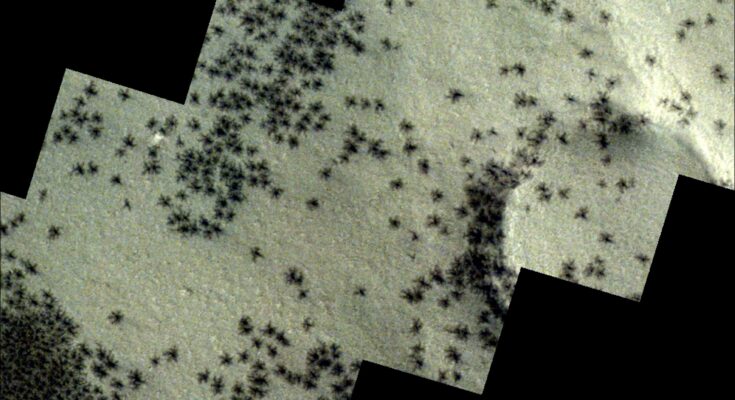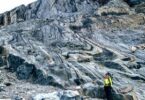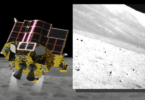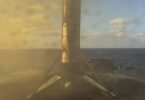This image shows features known as “spiders” near the southern hemisphere of Mars, as seen by the CaSSIS (Colour and Stereo Surface Imaging System) instrument on ESA’s ExoMars Trace Gas Orbiter. The data for this image was taken by CaSSIS on October 4, 2020. The image is centered at 323°E/75°S. Credit: ESA/TGO/CaSSIS
ESA’s Mars Express captured remnants of “spiders” scattered across the south polar region of Mars.
Rather than being actual spiders, these small, dark features appear when spring sunlight hits the carbon dioxide that seeps in during the dark winter months. Sunlight causes the carbon dioxide ice in the lower layer to turn into a gas, which then accumulates and penetrates the ice sheets. The gas erupts in the Martian spring, dragging dark matter up as it goes, and shattering ice up to meters thick.
The resulting gas, full of dark dust, bursts through cracks in the ice in the form of tall fountains or geysers, before falling to the ground and settling on the surface of the water. This creates dark spots between 45 m and 1 km in diameter. This same process creates “spider-shaped” patterns embedded in the ice – so these dark spots are a clear sign that spiders may be present.
One of ESA’s Mars probes, the ExoMars Trace Gas Orbiter (TGO), has a picture of spider tendrils in very clear detail (see image above). Spiders captured by TGO sit near, but outside, the area shown in this new Mars Express image. The Mars Express view shows dark spots on the surface created by escaping gas and material, while the TGO view also captures the web-like channels carved into the ice below.
The dark spots mentioned above can be seen all over the Mars Express image, creeping across the high hills and flat plains. However, many can be seen as small dots in the dark area on the left, which is located on the outskirts of the part of Mars called Inca City. The reason for this name is not a secret, and the network of almost geometric networks is reminiscent of the Inca ruins. Also known as Angustus Labyrinthus, Inca City was discovered in 1972 by NASA’s Mariner 9 explorer.
A rectangular slice of Mars is shown here in brown and brown tones. The area is dark to the left, and becomes lighter and lighter to the right. Swirling of different material deposits can be seen in the middle part of the image. On the left, two important features can be seen: the raised network of channels, like the network and walls known as the Inca City, and the scattering of dark spots that indicate the presence of known features as ‘ribs’ under the ice. Credit: ESA/DLR/FU Berlin
This new view of Inca City and its hidden arachnid inhabitants was captured by Mars Express’ High Resolution Stereo Camera.
A strange beginning
We do not know exactly how the Inca City was founded. The sand dunes may have turned to stone over time. Perhaps things like magma or sand are seeping through the broken Martian plate. Or, the eskers can be “eskers,” curved structures associated with ice.
The “walls” of the Inca City appear to follow the section of a great circle, 86 kilometers in diameter. Scientists therefore suspect that the ‘city’ is located within a large valley that itself is shaped like that. with a stone from space falling on the earth. This impact may have caused faulting in the surrounding plain, which was then filled with volcanic lava and has been in place since time immemorial.
Towards the middle of the picture, the landscape changes somewhat, with large round and oval waves that create an effect reminiscent of marble. This effect is thought to occur when layered deposits are depleted over time.
This rectangular image shows part of the Martian surface as if the viewer is looking down and across the landscape, and the irregular, mottled soil appears in brown and brown tones. Credit: ESA/DLR/FU Berlin
In the center right of the frame are steep, flat hills and hills that rise more than 1,500 feet above the surrounding landscape. These soft objects are eroded over time by the flow of wind, water or ice, leaving behind the hard objects that make up these hills.
The land to the right (north) is still covered in fine, light-colored dust. Other signs of chickens can be seen scattered in the highlands here, lurking in the various ravines and hollows.
Exploring Mars
Mars Express has revealed a lot about Mars over the past two decades and counting. The orbiter continues to image the surface of Mars, map its minerals, study the composition and circulation of its atmosphere, explore its subsurface and study its environment. Mars.
The HRSC spacecraft has shown us everything from wind-carved ridges to craters on the sides of mighty volcanoes to impact craters, tectonic faults, channels of rivers and ancient lava pools. The project has been very fruitful throughout its life, creating a more complete and accurate understanding of our planetary neighbor than ever before.
#Signs #spider #event #Mars






